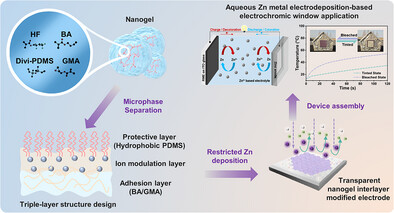Bionic Nanogel Interfaces Unlock Long‐Term Stability in Zn Metal Electrodeposition‐Based Electrochromic Windows
IF 26.8
1区 材料科学
Q1 CHEMISTRY, MULTIDISCIPLINARY
引用次数: 0
Abstract
Aqueous zinc (Zn) metal electrodeposition‐based electrochromic windows (AZWs) are a promising dynamic window technology due to their use of low‐cost, nonflammable, nontoxic, and highly conductive aqueous electrolytes. However, their development is hindered by issues such as poor reversibility, byproduct formation, and hydrogen evolution, which limit the optical window and cycling lifespan. Herein, a bionic transparent nanogel interlayer (TGI) in triple‐layer structure introduced on both Zn electrode and indium tin oxide (ITO) glass electrode is demonstrated to achieve highly reversible electrochemical reaction. In the spontaneously formed triple‐layer nanogel architecture, the top hydrophobic protective layer effectively mitigates water corrosion and suppresses hydrogen evolution reactions as well as byproduct formation. The middle layer incorporates internal fluorinated functional groups to promote uniform and rapid Zn ion transport. The bottom colloidal adhesion layer dynamically adapts to the substrate surface, preventing detachment due to morphology changes during cyclic Zn deposition/stripping processes. Consequently, the AZWs incorporating TGI@Zn and TGI@ITO glass electrodes exhibit excellent electrochemical properties and solar heat modulation abilities, which are attributed to their enhanced reversibility and uniform deposition of Zn ions. Compared with the single‐layer interlayer, the three‐layer structure design significantly improves the electrode's stability and performance, providing new ideas for designing next‐generation AZW electrodes.

仿生纳米凝胶界面解锁基于锌金属电沉积的电致变色窗口的长期稳定性
基于锌金属电沉积的电致变色窗(azw)是一种很有前途的动态窗技术,因为它使用了低成本、不易燃、无毒和高导电性的水性电解质。然而,它们的发展受到诸如可逆性差、副产品形成和氢演化等问题的阻碍,这些问题限制了光学窗口和循环寿命。本文将仿生透明纳米凝胶夹层(TGI)引入到锌电极和氧化铟锡(ITO)玻璃电极上,实现了高度可逆的电化学反应。在自发形成的三层纳米凝胶结构中,顶部的疏水保护层有效地减轻了水腐蚀,抑制了析氢反应和副产物的形成。中间层引入内部氟化官能团,促进锌离子均匀快速输运。底部胶体粘附层动态适应衬底表面,防止在锌沉积/剥离循环过程中因形貌变化而脱落。因此,含有TGI@Zn和TGI@ITO玻璃电极的AZWs表现出优异的电化学性能和太阳热调制能力,这归功于它们增强的可逆性和均匀的Zn离子沉积。与单层中间层相比,三层结构设计显著提高了电极的稳定性和性能,为下一代AZW电极的设计提供了新的思路。
本文章由计算机程序翻译,如有差异,请以英文原文为准。
求助全文
约1分钟内获得全文
求助全文
来源期刊

Advanced Materials
工程技术-材料科学:综合
CiteScore
43.00
自引率
4.10%
发文量
2182
审稿时长
2 months
期刊介绍:
Advanced Materials, one of the world's most prestigious journals and the foundation of the Advanced portfolio, is the home of choice for best-in-class materials science for more than 30 years. Following this fast-growing and interdisciplinary field, we are considering and publishing the most important discoveries on any and all materials from materials scientists, chemists, physicists, engineers as well as health and life scientists and bringing you the latest results and trends in modern materials-related research every week.
 求助内容:
求助内容: 应助结果提醒方式:
应助结果提醒方式:


